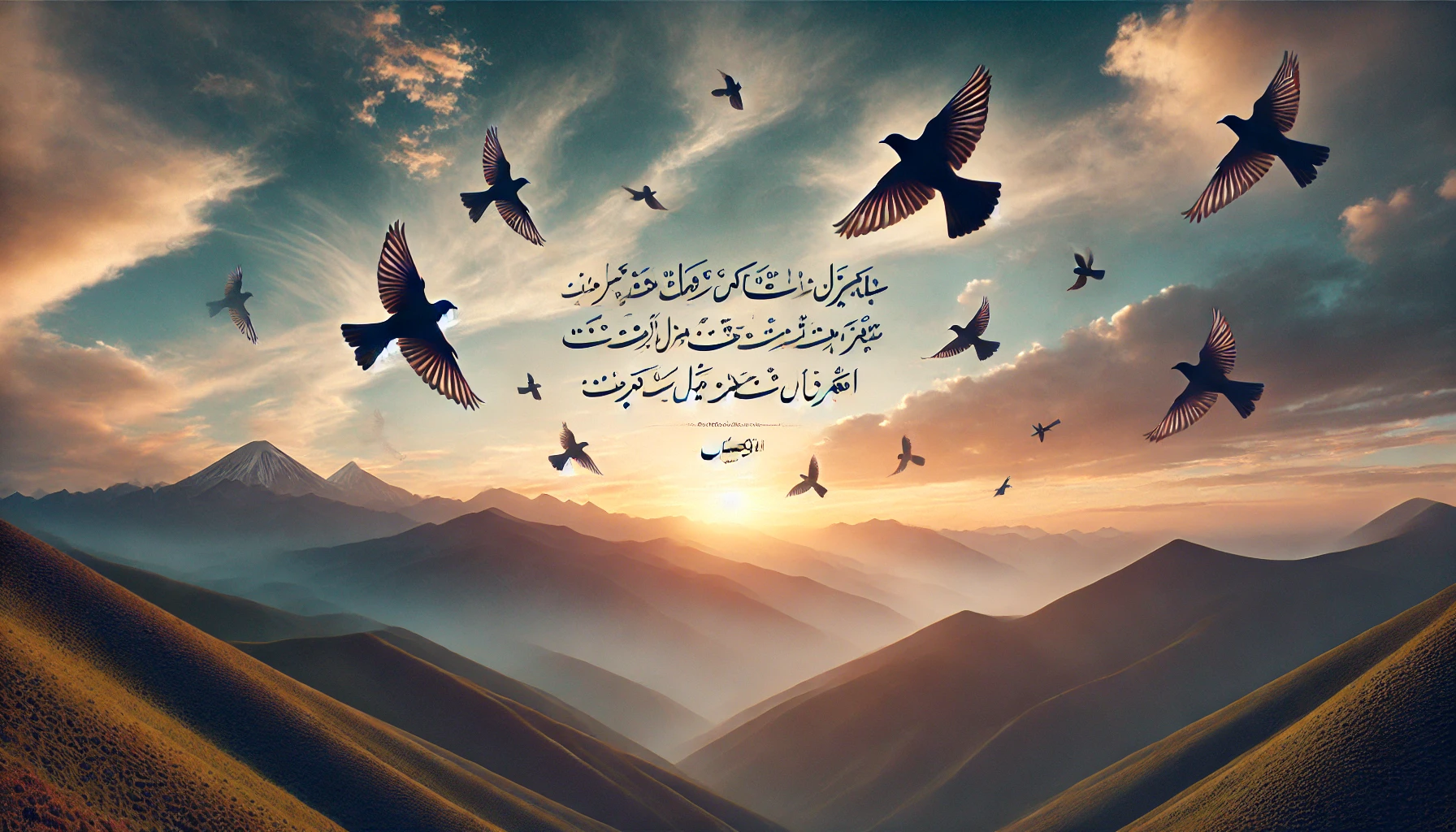Jalaluddin Rumi, one of the most revered Persian poets, used nature extensively in his works, and the imagery of wild birds frequently appears in his Farsi poetry. These birds symbolize freedom, spiritual awakening, and the journey of the soul. Through Rumi’s mystical verses, wild birds become messengers of divine truths, bridging the human experience with the spiritual realm.
The Symbolism of Wild Birds in Rumi’s Farsi Poetry
Wild birds in Rumi’s poetry serve as profound metaphors. These creatures, untamed and free, mirror the human soul’s desire to break free from worldly constraints.
Common Symbolic Meanings of Wild Birds in Rumi’s Poetry:
- Freedom: Representing liberation from material bondage.
- Spirituality: Acting as symbols of the soul’s journey toward enlightenment.
- Connection to Nature: Reflecting harmony with the divine.
In one of his verses, Rumi writes:
“Don’t be satisfied with stories, how things have gone with others. Unfold your own myth, as the bird unfolds its wings.”
This highlights the transformative journey of self-realization.
Wild Birds as Messengers in Rumi’s Mystical Universe
Birds in Rumi’s poetry are often depicted as divine messengers, connecting the mortal world with the divine. Their flight signifies ascension, and their songs echo divine truths.
Examples of Birds in Rumi’s Work:
- The Simurgh: A mythical bird representing unity with God.
- The Nightingale: Often a symbol of longing and love for the Divine.
- The Hoopoe: A guide in spiritual journeys, famously featured in “The Conference of the Birds” by Attar, which influenced Rumi.
Themes of Freedom in Rumi’s Farsi Poetry Wild Birds
Rumi’s use of wild birds reflects the deep yearning for spiritual freedom. He often portrays the soul as a caged bird, longing to break free.
Famous Verses on Freedom:
“The soul wants to fly away when caged, like a bird longing for the open sky.”
This imagery teaches us to detach from earthly possessions and seek a higher purpose.
The Influence of Sufism on Rumi’s Bird Imagery
Sufism, a mystical branch of Islam, profoundly shaped Rumi’s worldview. In Sufism, the flight of wild birds symbolizes the spiritual seeker’s path to enlightenment.
Key Aspects of Sufism in Rumi’s Bird Metaphors:
- Journey: The soul’s ascent, akin to a bird’s flight.
- Unity with the Divine: Birds symbolize merging with God’s essence.
- Detachment: Emphasis on leaving worldly attachments behind.
Rumi’s Farsi Poetry Wild Birds: A Gateway to the Divine
In many of Rumi’s verses, birds appear as guides or inspirations for those seeking God. Their wild nature reminds readers of the untamed, boundless spirit of the Divine.
Lessons from Rumi’s Poetry on Wild Birds
Rumi’s verses not only evoke beauty but also impart timeless wisdom.
Key Lessons:
- Embrace Freedom: Just as wild birds are free, the soul should transcend limitations.
- Seek Higher Truths: The flight of a bird mirrors the journey toward spiritual enlightenment.
- Live in Harmony with Nature: Rumi reminds us of our connection to the natural world.
The Conference of the Birds and Its Influence on Rumi
The Conference of the Birds by Attar, a predecessor of Rumi, played a pivotal role in shaping Rumi’s depiction of birds. This epic poem narrates the journey of birds in search of their king, the Simurgh.
Parallels Between Attar and Rumi:
- Both poets use birds to symbolize the soul’s spiritual quest.
- The Hoopoe in Attar’s work appears as a wise guide, similar to Rumi’s bird imagery.
Wild Birds and the Theme of Love in Rumi’s Poetry
Love, a recurring theme in Rumi’s works, is often depicted through the metaphor of wild birds. Birds signify the soul’s passionate longing for the Beloved.
Famous Lines on Love:
“Be like a bird who spreads love’s wings, soaring toward the infinite.”
Rumi’s Farsi Poetry Wild Birds in Modern Context
Today, Rumi’s poetic depictions of wild birds resonate deeply with those seeking spiritual meaning in a chaotic world.
Why Rumi’s Bird Imagery Is Timeless:
- Birds symbolize universal concepts of freedom and longing.
- They inspire readers to transcend daily struggles and seek higher purposes.
How Rumi’s Wild Birds Speak to Today’s Readers
Modern readers often find comfort and guidance in Rumi’s bird metaphors.
Why Rumi’s Birds Resonate:
- Symbol of Inner Strength: Wild birds inspire resilience.
- Call for Freedom: A reminder to break free from societal constraints.
- Connection to Nature: Encourages mindfulness and ecological awareness.
Creating Your Own Journey Inspired by Rumi’s Birds
Drawing from Rumi’s poetry, you can embark on a personal journey of spiritual growth:
- Reflect on your inner desires and aspirations.
- Identify what “cages” you, whether emotional or material.
- Embrace practices that set your spirit free, like meditation or spending time in nature.
Also read: Dimensions Waterway Plastics SGSMF115 Pump 1.5HP 1SP
Conclusion
The Rumi Farsi poetry wild birds metaphor is a profound reflection of the soul’s longing for freedom and connection with the Divine. Through these vivid images, Rumi invites us to explore life’s mysteries, transcend worldly confines, and embrace the journey of spiritual awakening. Whether read as poetry or spiritual guidance, Rumi’s wild birds continue to inspire and uplift, carrying timeless messages of hope and freedom.
FAQs
What do wild birds symbolize in Rumi’s poetry?
Wild birds in Rumi’s poetry symbolize freedom, spiritual ascension, and the soul’s journey toward God.
How is Sufism reflected in Rumi’s bird imagery?
Sufism influences Rumi’s use of birds to depict the seeker’s spiritual journey, emphasizing detachment and unity with the Divine.
Why are wild birds a recurring theme in Rumi’s works?
Wild birds represent the untamed spirit of the soul, longing for freedom and higher truths.
How did Attar influence Rumi’s use of bird imagery?
Attar’s Conference of the Birds inspired Rumi’s use of birds as symbols of spiritual guidance and enlightenment.
What lessons can be learned from Rumi’s bird metaphors?
Rumi teaches readers to embrace freedom, seek spiritual truths, and live harmoniously with nature through his bird imagery.
How do Rumi’s wild birds relate to modern spirituality?
Rumi’s wild birds encourage contemporary readers to pursue inner freedom and find peace in a chaotic world.



